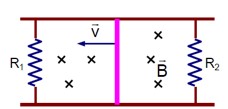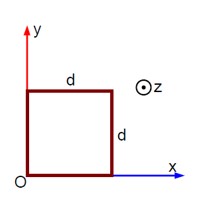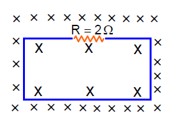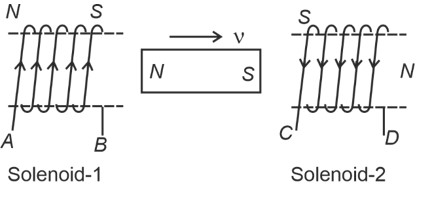Electromagnetic Induction
Get insights from 124 questions on Electromagnetic Induction, answered by students, alumni, and experts. You may also ask and answer any question you like about Electromagnetic Induction
Follow Ask QuestionQuestions
Discussions
Active Users
Followers
New answer posted
3 months agoContributor-Level 10
Since B, v and length are perpendicular
ε = Bvl
emf will induce only in wire CD
ε = B (d)v? (d) = B? (d/a)v? d = B? v? d²/a
New answer posted
3 months agoContributor-Level 10
E = -dφ/dt = - (20t + 20) mV.
At t=5s, E = - (100+20) = -120mV.
I = |E|/R = 120mV/2Ω = 60mA.
New answer posted
3 months agoContributor-Level 9
ε = |dΦ/dt| = A|dB/dt|
Given B (t), dB/dt = (4/π) * 10? ³ * (-1/100)
ε = (π * 1²) * | (4/π) * 10? ³ * (-1/100)|
= 4 * 10? V
To find when B=0:
B = 0 ⇒ 1 - t/100 = 0
⇒ t = 100 second
Energy Dissipated, E = P * t = (ε²/R) * t
E = (4*10? )² / (2*10? ) * 100 = 80mJ
New answer posted
3 months agoContributor-Level 9
I = I? e? /?
= (20/10000) e^- (1*10? / 10*10? ³)
= 2 * 10? ³ e? ¹
The provided solution calculates as:
= 2 * 10? ³ e? ¹
= 2e? ¹ mA
= 2 * 0.37mA
= 0.74 mA = 74/100 mA
(Note: There seems to be a calculation discrepancy in the source image, the steps shown lead to I = 2e? ¹ mA)
New answer posted
4 months agoContributor-Level 10
A magnetic pole will repel or attract magnetic sheet so force is need.
B. If sheet is non-magnetic, no force needed.
C. If it is conducting, then there will be addy current in sheet, which opposes the motion. So forces is needed move sheet with uniform speed.
D. The non-conducting and non-polar sheet do not interact with magnetic field of magnet.
New answer posted
4 months agoContributor-Level 10
The magnitude of magnetic field due to circular coil of turns is given by
New answer posted
4 months agoContributor-Level 10
North of magnet is moving away from solenoid 1 so end of solenoid 1 is South and as south of magnet is approaching solenoid 2 so end of solenoid 2 is South.
Taking an Exam? Selecting a College?
Get authentic answers from experts, students and alumni that you won't find anywhere else
Sign Up on ShikshaOn Shiksha, get access to
- 66k Colleges
- 1.2k Exams
- 680k Reviews
- 1800k Answers





